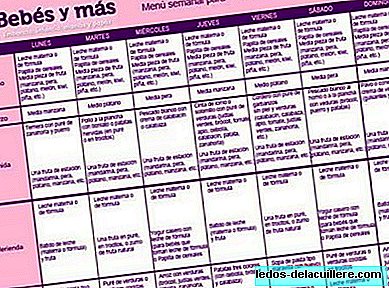
After the weekly menu for babies from 6 to 9 months, we have developed a Weekly menu for babies 9 to 12 months.
The nutritional needs of babies between 9 and 12 months are basically the same as children between 6 and 9 months. The objective of this stage is that once the introduction of solids has begun through the initiation of complementary feeding, the baby will be offered a greater variety of flavors and textures.
Their diet is still based on milk, either breast or formula, but the baby needs a greater amount of nutrients, mainly iron, which is provided by food.
Three months have passed since the introduction of solids and little by little new flavors can be incorporated into the diet, expanding the variety of fruits, vegetables and meats. Of course, remember that new foods should be offered always separately for a couple of days to check that there is no allergic reaction in the baby.
Foods that are incorporated after 9 months
Vegetables are the same that can be offered after 6 months, which are the majority, except the green ones such as spinach and chard, asparagus, beets and cabbage.
As for meats, once you have tolerated the most easily digestible white meats such as chicken, turkey and rabbit, you can incorporate another type of more fatty meats like the lamb, the kid, the lamb, the veal and the pig. The chicken parts that must be offered are the breast or the thigh, always without skin. Pork, lean pieces such as tenderloin or sirloin, for being juicy and without nerves.
From 9 months, although without hurry, the same can be at 10 months or closer to the year, you can start offering fish in infant feeding. There are different opinions about the age of introduction of fish. The AEPED recommends it after 9 months, but there are pediatricians who delay it until one year, especially if there is a history of allergy in the family. At the beginning, only white fish (swordfish, conger, sole, cod and hake) and blue fish, more fatty, from 18 months.
As for the fruit, the basic ones with which the complementary feeding is usually started (apple, pear and banana) the rest of the fruits can be presented to the baby like plum, kiwi, pineapple, grapes, tangerine, orange, and summer fruits, except peaches, medlars, apricots and red fruits.
Sample weekly menu for babies 9 to 12 months
As in the previous menu for smaller babies, the menu we have developed It is an indicative example. Every baby is different. Some eat more than others, some will accept some foods better than others and it is only you who will have to try until you find what you like and accept best. If you see that it rejects some food, you leave it and try again after a few days. Do not force it.
The menu includes a daily protein ration in food, either through meat or fish. The fish, I repeat, must be introduced gradually, it is not necessary to give it at 9 months.
It also includes a serving of legumes, which can be combined with rice to enhance its nutritional value. From 9 -10 months, chickpeas can be offered, although until the year preferably without skin to facilitate digestion.
You will see one good amount of fruit, about three pieces a day. There are children who do not accept it too well, so do not force them. In that case, eliminate the fruit from breakfast or mid-morning.
With respect to the schedules, lunch is a mid-morning meal, but there may be children who do not eat it either because they eat breakfast late or eat early. That varies, depending on the needs and routine of each child.
We make the same recommendation that we have made for babies from 6 to 9 months. Breast milk remains the main food of the diet of the breastfed baby and although we have placed it on the menu at breakfast, snack and dinner (before bedtime) should continue to be offered on demand, to cover the recommended amount of 500 ml daily, also recommended for babies who drink artificial milk.
When we put homemade yogurt made with formula milk, it is a snack variant for babies fed with artificial milk. Here you have the recipe. For babies fed with breast milk is not recommended, because of the risk of allergy and intolerance. If you drink breast milk, keep drinking.
You can combine the dishes as you like. The accompaniment of vegetables is indicative with a list of them so that you can test which ones the baby accepts best. If you reject any, you leave it and try again after a while. The idea is to offer them variety to try new flavors.
You can also offer the dish at night at noon and the one at noon at night, but we have preferred to avoid the most protein dishes at night, to facilitate rest.
And finally, in case you lack inspiration, I leave you with some recipes for children under one year, and others.
Clicking on the image above the larger menu will open, and if you want you can print it.












